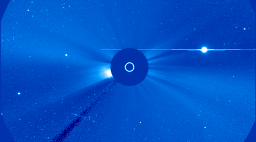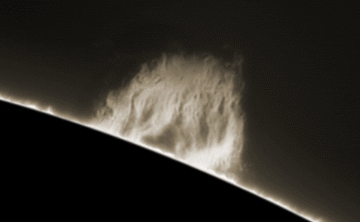Our Sun Reaching Out
Every few months, my wife asks me why I'm not studying the Sun professionally. "It is just SO COOL!" So I feel obligated to regularly post cool solar photos, otherwise she might stop reading my blog and posting comments.
Here's a nice image taken by Alan Friedman and posted at SpaceWeather.com. This rather large solar prominence occurred October 7, 2006.
Here's a nice image taken by Alan Friedman and posted at SpaceWeather.com. This rather large solar prominence occurred October 7, 2006.
Here is another nice static photo of the same event caught by Pete Lawrence over in the UK.

Note that you too can take stunning solar photographs with a few hundred dollars of equipment.
Here's a link to the Coronado Personal Solar Telescope that was used to take these images.
Here's a link to the Coronado Personal Solar Telescope that was used to take these images.

There are a couple of versions with different color filters passing either the Hydrogen-Alpha band (deep Orange seen above that shows surface structure and prominences) or the Calcium K band (blue that shows internal activity in the photosphere). It can be purchased starting at about $500 online at Telescopes.com, Adorama, Astronomics, B&H Photo, or Scope City. Astronomics will even include a cheap digital eyepiece that you can hook up to your television for free with the PST.
The 2.5x Powermate is an eyepiece extender which magnifies the image 2.5 times and can be had for around $195.
The 2.5x Powermate is an eyepiece extender which magnifies the image 2.5 times and can be had for around $195.

The camera can be the expensive part, ranging from simple web cams for about $60 (which, if you are even a little bit of a hardware hacker, can actually generate astounding images), all the way to something by Ginfer Lakes Instruments for tens of thousands of dollars. A moderately nice, readily available CCD camera, the Deep Sky Imager Pro, can be had from Mead for around $500 with color filters.

Of course there are infinite opportunities for unlimited investment in this sort of thing, but the point is that you can take credible images for under $600. Every school should have one of these setups!
If anyone is seriously considering this idea, just email or post a comment and I'm happy to offer more personal advice.
Update: Here's one more from SOHO, NASA's Solar and Heliosphereic Observatory. The three bright spots are (left-to-right) the binary star Spica, Mars, and Venus. The coronal mass ejection is obvious.

Link from Spaceweather.com
























2 comments:
Me too Phil
This just supports my notion that one of these days, you need to quit your job and go study the sun full time. It's just so cool!
Post a Comment